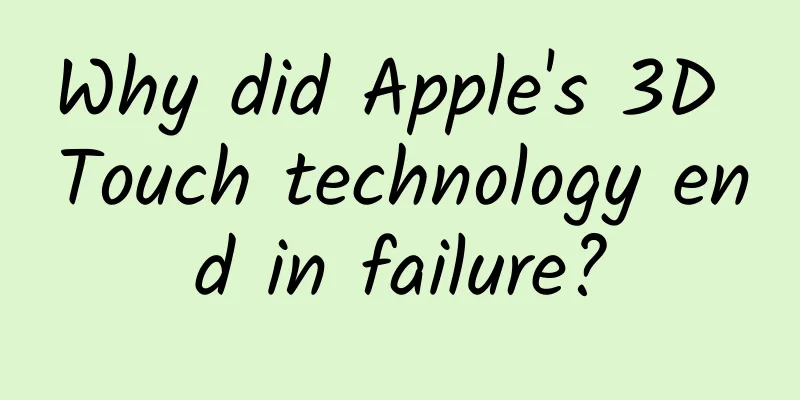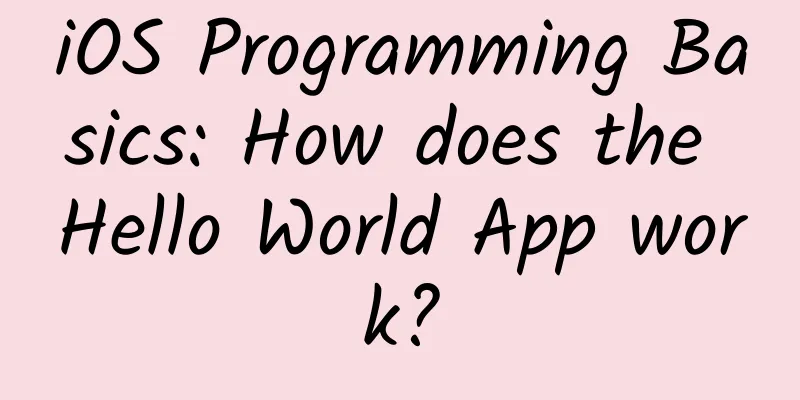Why did Apple's 3D Touch technology end in failure?

|
On September 21, why did Apple's 3D Touch feature end in failure? Foreign media Hackernoon analyzed the reasons from the perspective of user experience, saying that the technology is not very practical, does not bring any improvement to the iPhone's interaction method, and conflicts with the iPhone's original light touch touch method. The following is the main content of the article:
Last week, Apple released a new generation of iPhone. Most of what was announced at the event was in line with what we'd expect from a new Apple product, except for a more modern, larger model with a 6.5-inch screen. This is the largest phone the company has ever released. iPhone XS The launch of the iPhone XR marks a dramatic shift in Apple's product strategy, one that could change the future of the iPhone and alter the way it's made and marketed. The iPhone XR is a strange phone, and it’s different in the following ways: It’s cheaper than the XS, but larger (the XS has a 5.8-inch screen, while the XR has a 6.1-inch screen). It also uses the A12 Bionic processor like the XS. However, it has 3GB of RAM (the same as the iPhone X), while the XS has 4GB. This means that this phone is faster than the iPhone X, but slightly slower than the XS. It offers a 128GB storage option, the only model in the iPhone X series to offer this storage option; It uses a single camera rather than dual cameras, but it can still use software (similar to the Google Pixel phones) to create a depth effect in portrait photos; It comes in six different colors, and here Apple is using the old strategy of creating demand for variety. However, the back of this phone uses high-quality glass, which will have a huge impact on how it is marketed (remember the iPhone 5c? That model was cheap, this is not cheap); It has a "Liquid Retina" LCD screen that's not as good as the OLED displays used on the X and XS, but better than the LCD screen used on the iPhone 8. Even though these phones are billed as “bezel-less phones,” they still have a small, rounded bezel. The iPhone XR’s screen has a noticeably larger bezel than the X and XS. Finally, the iPhone XR’s screen doesn’t have 3D Touch. Apple has apparently given up on that feature. To me, this last point is the most important one in Apple’s latest product strategy. It seems that Apple is preparing us to a future where Apple’s flagship product line will not have 3D Touch. So, the question is , why did this feature fail, and what does it mean for the future of the iPhone? I spent the past few days analyzing the user experience and history of the ill-received 3D Touch and trying to articulate how the disappearance of 3D Touch will reshape the future of Apple’s most important product. 3D Touch is a solution to a manufacturing problem. Apple introduced 3D Touch / Force Touch in 2014 as an embedded technology in its evolved trackpad. This technology is complementary to the Haptic Engine technology. The main goal of the Haptic Engine technology is to reproduce the tactile sensation of mechanically pressing a button. This is a major shift in Apple's industrial design strategy, which has always tended to reduce mechanical parts that are easily disconnected from the user experience. Force Touch technology for Macbook notebook trackpads The technology made its way to the iPhone and Apple Watch in 2015, with the idea of bringing a new way of interacting with touch devices. The "transformative" technology was one of the main selling points of the iPhone 6S. As a designer, I remember when I first saw the demo video, I was very excited about the new level of interactivity it brought. But watching it again three years later, it became clear. This is a manufactured solution to a problem. None of the interactive features demonstrated in the video are very practical. For example, what Apple chief designer Jonny Ive calls a “peek and pop” interaction is just a gimmick for opening resources like photos and URLs. The video doesn’t even show how the full shortcut flow triggered by 3D Touch works, just focusing on the contextual menu. Judging from the video, this technology is an advancement in touch sensing technology, but the reality is that even in the promotional video, it fails to show practical uses. It seems that Apple's strategy with 3D Touch is to use this technology as the basis of their sensor products and let the developer community come up with creative ways to use it and enhance the user experience. This is not the first time Apple has done this, and some of their most groundbreaking technologies are based on the same logic. So why didn’t 3D Touch take off? After digging deeper into the feature, I discovered the following: Extremely unpopular with developers This may be the reason why 3D Touch failed, or this may be the result of the failure of 3D Touch. Either way, the fact is that the feature did not succeed. I tested app icon shortcut menus on a sample of 200 popular iPhone apps. Only 40% of them had 3D Touch shortcut menus. That adoption rate doesn’t sound too bad until you start digging into the details of their implementation. For example, Google seems to include 3D Touch context menus in every app, but their implementation is inconsistent: Sheets has no context menu, while Docs does. For a set of applications that are part of the same office suite, it's surprising to see such inconsistency. Google Sheets app has no 3D Touch menu Google Docs has a 3D Touch menu Popular apps like Lyft and Bumble don't have a quick menu, while Uber only has one for its ride-hailing app, not its UberEats food delivery app. Lyft's ride-hailing app doesn't have a 3D Touch menu Many apps have shortcuts, but they just don't work. While testing different shortcuts, I noticed that some apps tried to deep link to the view or function they described and then got stuck on a white screen. Most apps that offer 3D Touch shortcut menus don’t offer much value in their menus. For example, the only option the DoorDash food delivery app offers through its shortcut menu is “Search.” DoorDash 's 3D Touch shortcut menu Those shortcuts are repetitive and can be accessed without the need for a 3D Touch interaction. I’ll go into that in more detail below. Duplicate and overlapping user paths Let's take a minute to imagine that 3D Touch technology is the productivity-boosting and time-saving tool it claims to be. This means that by using it, you can speed up your workflow and complete tasks in fewer steps, right? However, in all my testing, I didn't find a shortcut that was more practical or usable than just using an app with standard touch functionality. Instagram is a great example of this. Let’s take its camera shortcut as an example. If I want to open the camera through the 3D Touch menu, I have to do the following: 1) Find the Instagram app icon, 2) long-press it, 3) tap the Camera menu item. Now, if I want to open the camera via traditional touch interaction, I have to do the following: 1) Find the Instagram app icon, 2) tap it, 3) Swipe from left to right or tap the camera icon in the top left corner. Instagram 's 3D Touch shortcut menu Considering that the number of steps required to open the camera using both interaction methods is the same, there is no compelling reason to move away from the traditional touch interaction method. This problem also exists for other menu options that are slightly more functional and quicker, such as switching accounts. There is no reason to rely on an interaction method that provides limited or sometimes no improvement. Extremely poor discoverability This is probably the most well-known problem with this technology. 3D Touch is not discoverable in the user interface (UI) layer. If you want to understand the kind of control this interaction allows, you have to long-press everything on the screen and expect some output, and sometimes when you get output, it’s hard to understand what kind of functionality the interaction allows. Apple doesn’t even attempt to provide guidance on how to improve discoverability of 3D Touch. Their Human Interface Guidelines offer no instructions for the feature, other than explaining some details of the useless “peek and pop” concept. Unreliable interactions and an ergonomic nightmare If you want to experience what arthritis feels like, I recommend using 3D Touch on your iPhone all day long. It's an ergonomic nightmare. The main problem is that it's hard to determine the right amount of pressure to trigger an interaction. At the default sensitivity setting (medium), sometimes a light touch seems to trigger an interaction, but most of the time it doesn't. After unsuccessful attempts to trigger 3D Touch, most users press harder on the screen, increasing the force to initiate the interaction, and sometimes users apply well over 100 grams of pressure to trigger 3D Touch. I'm not saying this is the actual amount of pressure required to trigger an interaction, but once the first trigger fails, users will likely feel that they need to use a lot of force to trigger it. Sometimes, you'll find yourself triggering 3D Touch with just a quarter pound of pressure, so this feature is completely unrealistic for daily use. Conflict with the original touch concept The iPhone is largely a touch device. It has other input mechanisms, such as a microphone, accelerometer/gyroscope, and camera, but none of these mechanisms can compare to the effectiveness and efficiency of a touch screen. Touch has become an extremely popular input mechanism, and the anatomy of the human hand is expected to change due to the way we use our hands to use technology devices. This is perhaps why Apple thought it was a wise choice to add touch as an alternative method of interaction. They have indeed been very successful in providing multi-touch capacitive screens and the variety of control actions and interactions that this technology brings. 3D Touch, however, offers no practical advantage over typical capacitive touch. In fact, it actually makes things worse. Because 3D Touch is a feature that relies on physical pressure, it conflicts with the light-touch interaction that capacitive screens enable, which is the opposite of a very successful interaction method. Remember how frustrating it was to use a phone or device with a resistive touchscreen? 3D Touch brings back all the unnecessary impedance that made pressure-sensitive screens so frustrating. The Nokia 5800, with its resistive screen, is the most frustrating phone ever made. While it makes sense to try to increase interaction options, a technology like 3DTouch will inevitably face an existential crisis. As mentioned earlier, 3D Touch is an unreliable technology. It's hard to determine how hard you need to push 3D Touch, so it's hard to use consistently. But input isn't the worst part of the technology. 3D Touch is so limited in its role in the user interface that it cannibalizes the potential benefits that other technologies like the Taptic Engine bring to normal touch interactions. Since 3D Touch interactions are usually accompanied by tactile feedback from the haptic engine, fantastic technologies like the haptic engine have become "the foil for 3D Touch." While this isn’t necessarily why 3D Touch failed, it does explain how limiting the microcosmic world that 3D Touch created was. The feature didn’t really add value to the end user experience of the iPhone. The Future of 3D Touch With the introduction of the iPhone XR and the removal of 3D Touch, it’s clear what Apple intends to do with the technology going forward. However, removing the feature from its highest-end product line is more challenging than deciding not to add it to future phones. Apple's strategy of continually raising the prices of its high-end models appears to be working. But that strategy can only work if Apple continues to add new features that justify the premium. Removing 3D Touch is a challenge primarily because it means removing a specific technology that helps justify the pricing of a premium device. It's unlikely that Apple would remove this technology without finding a viable replacement, even if it's just a software-based alternative input method like knuckle detection. There's also the less likely possibility that Apple is working on a new iteration of the technology, or even some kind of weight-sensing screen that would allow the device to act as a small food scale, like the iPad. Of course, anything is possible, and the iPhone XR could also herald a new product strategy for Apple's high-end models, which could also be influenced by the XR's new approach to technology integration and deployment. Alternatively, a replacement for 3D Touch technology could be used in the Apple Pencil stylus, or it could be used to launch an Apple Pencil Mini and a special iPhone case with a pen clip. Regardless, the reality is that 3D Touch is dead, and Apple is still exploring… |
<<: Foreign media review: iPhone XS series is not much better than iPhone X
Recommend
Is the blue I see the same blue you see?
The differences in the physical structure of the ...
A successful H5 should hit the user's key points and achieve the operation purpose
Without discussing how to define “success”, can y...
Meituan Operations: The Marketing Logic of Meituan Takeaway Monthly Card
Buy monthly pass at super low price First, let’s ...
After quitting smoking, can the blackened lungs become "white" again? Here comes the answer...
If you smoke for a long time and accidentally mak...
WeChat can also perform performance testing & clean up space, and experience the new features in detail
WeChat avatar performance testing tool What? WeCh...
A must-go place for tea drinking and tasting in Kunming, with its own high-end studio
Kunming tea tasting has its own studio. Recommend...
If used properly, it can save lives; if used improperly, it can be fatal. What exactly is "adrenaline"?
When the human body is frightened, feels threaten...
A small sleeping habit may damage the heart and blood vessels! Check if you have it
Some time ago, a celebrity wore a mouth guard to ...
It’s confirmed, drinking coffee is actually good for your health?
For many people, coffee It has a refreshing effec...
How to plan an anniversary event? Teach you step by step
This article is a homework assignment, which is t...
Introduction to Baidu’s information flow advertising promotion billing methods and creative forms!
What is information flow advertising? Information...
What is the difference between a Chinese businessman buying masks priced at 10 million yuan and a Chinese businessman buying masks priced at 10 million yuan?
Chinese businessman buys masks worth 10 million y...
5 Best AngularJS Program Building Frameworks
[[151096]] If you are planning to use AngularJS t...
What happened when a Tsinghua University student sued ofo for 400 yuan in compensation? What is the specific situation?
What happened when a Tsinghua University student ...









